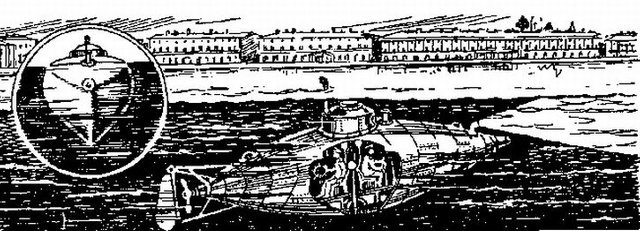The first submarines of the Russian Navy
In the Russo-Turkish War of 1877-1887. The Russian fleet used a new type of weapon - the sixth mine.

Not a pole with a length of 12-15 m, a powder charge was attached; The pole was mounted on the boat so that the charge was at a shallow depth under the water. The mine boat, thanks to its small size, could stealthily approach the enemy ship and, leading the mine to the side of the ship, below the waterline, to blow up the charge. The considerable length of the pole provided relative safety to the attacker himself.
Naturally, the main thing for this kind of operations was secrecy and they were carried out exclusively at night. In the role of boats in military conditions, various small vessels were used - all that could be found.
The task of creating invisible boats was undertaken by the Russian engineer Stepan Karlovich (Stefan Kazimirovich) Dzhevetsky. When the war with Turkey began, Dzhevetsky went to her as a volunteer. He served as a private in the Black Sea Fleet, was awarded the St. George Cross for bravery.
After the war, Dzhevetsky stayed in Odessa and started designing. He wanted to create an apparatus that could quietly get close to an enemy ship and lay a mine. In order for this to be done in the afternoon, Dzhevetsky saw the only way out: the apparatus must move under water. He developed a draft of such a vessel, and, with the help of a sponsor, built it at the Gula Blanchard plant.
In the autumn of 1878, a test was held in the Odessa raid, followed by the Chief Commander of the Black Sea Fleet, Vice Admiral N.A. Arkas. Dzhevetsky, submerged in his boat under the water, was able to detect a nearby barge-target, attach a mine to its bottom, retreat to a safe distance and blow it up. The boat was driven by pedals like a bicycle.
Fleet management became interested in the project. In 1879 a second submarine was built at the Nevsky Plant. It was larger - the crew consisted of four people, she had two propellers.
January 29, 1880 Dezhavetsky showed the boat to the heir to the throne of the Grand Duke Alexander Alexandrovich, the future Emperor Alexander III. The demonstration took place on the Silver Lake in Gatchina. The boat passed under the boat, where Alexander Alexandrovich was with his wife and destroyed a raft, prepared as a target.
The success was great: Dzhevetsky received the state. order. True, he had to improve the design and simplify the design of the boat. The crew was reduced and made up three people. The nose screw was decided to be removed.
For regeneration, the air was pumped through a solution of sodium hydroxide; if necessary, compressed air from the ballast tank could be used. All this made it possible to stay underwater for up to five hours. Inside the boat was not detached, the crew had to work in the dark. The speed of the boat under water reached 3 knots. The boat was loaded on 8 - 12 m.
Two mines served as armament. As an explosive material, pyroxylin was used. Mines lay in rubber bags with air, connected with each other by a cable. The boat was to go unnoticed under the keel of the enemy ship, then open the hatches under which the mines were placed. When the mines surfaced, the cable covered the bottom of the ship, and held mines on either side of the hull of the enemy ship. After that, the submarine was to retire to a safe distance and to charge charges with an electric wire.
In total, 50 boats were built: 25 in St. Petersburg, 25 more in Paris. 16 were left on the Baltic Sea, 32 were sent to Odessa. They were intended for the mine defense of sea fortresses, so they were not assigned to the fleet, but to serf mines. In the Naval Department boats were transferred only in 1988.
Soon a conclusion was made about the inapplicability of Dzhevetsky's boats to use. The main reasons were a short range and low speed - the pedal mechanism was not enough. Some of the boats were recycled (some were converted into buoys), some were mothballed. One was handed over to Dzhevetsky himself - for further work.
He really tried to improve his design - the pedal was replaced by an electric motor, powered by a battery.
It was this copy of the Dzhevetsky submarine that survived to this day. It is stored in the exposition of the CVMM of St. Petersburg, although, unfortunately, only the corps.
At the beginning of the Russo-Japanese War, one of the boats was rebuilt. Outside, they installed torpedo tubes and sent the boat to the Far East as a "psychological weapon". The boat was transported in such a way that the Japanese could see it. In combat, the submarine did not take part.
Djevetsky himself continued his design work. He developed a low-landing destroyer project. For the armament of submarines, Dzhevetsky created a " mine apparatus ". In Russia, they were not interested, but in several countries they adopted them. In 1907, Dzhevetsky designed a submarine " Pochtovy " with a gasoline engine.
Yeah. This post tell about history how we usually read in book